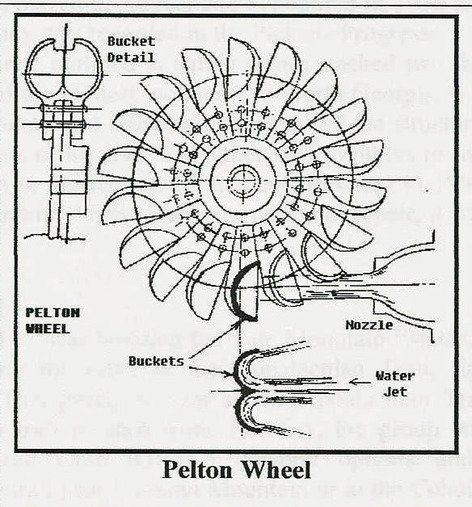Other Mountain Happenings
The Early Days before Bent Tree – Part 4
By: Don & Diane Wells
There are many stories, most not well-known, about this mountain area that can be shared. Parts 1- 3 of this series told about the Old Dude Ranch and the CCC Camp. We hope you find the ones we have chosen for parts 4 and 5 also interesting.
Water Power for the Marble Mills
One of Pickens County’s natural resources is marble. The deposits of marble are reported to be five to seven miles long, one/half mile wide and as deep as 2,000 feet. Henry Fitzsimmons established the first marble quarries and mill in the 1830’s. But it was not until the 1883, when the railroad arrived in Pickens County, that mining marble became a big business. The Georgia Marble Company was organized in 1884 and others, including the Southern Marble Company at Marble Hill, GA, soon followed.
Mining marble required power to run the machinery. Some of this power was supplied by water transported to the marble mill from what is now Bent Tree’s Oglethorpe, Hendrix and Mole Mountains. Stone, An Illustrated Magazine, Volume X, Dec 1894 to May 1895 reporting on the Southern Marble Company operations said that, “Power for the mill which contained five gang saws and two rip saws is supplied with water. A reservoir was constructed two hundred feet above the mill and waters of numerous mountain streams about two miles away are conveyed through ditches and pipes to the site. From here the water runs through a pipe gradually diminishing in size until it is finally discharged through a two inch nozzle against a Pelton undershot wheel and power enough is furnished thereby to drive the mill and the electric light plant.” Buck Skull and other springs located on the southern side Oglethorpe Mountain were the water sources mentioned in this report. Buck Skull was also the water source for the
Old Dude Ranch. In order to maintain a gravity flow some of the ditches werevery deep. Lillie Mae Pendley, who grew up on the southern slopes of the mountain in the 1930’s, told us about playing with her friends in the ditches that ran to the mill. The USGS map of Pickens County shows a lake off of Cove Road near Cowart Mountain Road that today is called the Georgia Marble Company Lake. This is probably the lake built to store the water for the marble mills.
The Oglethorpe Monument
Sam Tate became President of the Georgia Marble Company in the early 1900’s. Under his leadership the company became one of the most important industries in GA as well as in the United States. He was a man of vision with a passion for accomplishing new endeavors outside of his marble industry. Beginning in the late 1800’s and into the early 1900’s, he bought land stretching from Burnt Mountain to Oglethorpe Mountain. By 1928 he owned about 10,000 acres. In 1928, he started building the Tate Mountain Estates which he envisioned to be “the best mountain resort community east of the Mississippi River.” He planned to put this mountain area on the map” He petitioned the GA Legislature and the US Congress to change the name of the main mountain from Grassy Knob to Oglethorpe Mountain, named for the founder of GA. He wanted to erect a marble monument in honor of General Oglethorpe on top of the mountain. The GA Marble Company would build the monument and donate it and a five acre site to the state. He also wanted the monument area set aside as a state park but the area was not big enough to qualify. The monument, 38 feet high, was carved by Mr. Jimmy Watt of the Nelson Georgia Marble Plant. In order to transport the monument to the top of Mt. Oglethorpe, Tate had to complete the Burnt Mt. Road to Tate Estates and then build a road along the top of the mountain ridge to the monument location. The date for the monument dedication was initially set for July 1930 but the road was not complete by then and neither was the Connehaynee Lodge where Tate planned to house all of the dignitaries who were going to be at the ceremony. J. B. Hill, in a personal account of his experience with Sam Tate in selecting the site for the monument, reported in the November 7, 1991 Pickens Progress that all was ready by August 1930 and that L.C. Bearden and his crew got the monument to the top of Mt. Oglethorpe using the roads build by Sam Tate. Unfortunately, this major feat was not recorded with pictures. The Monument was placed in August and September of 1930 and dedicated on October 23, 1930. The ceremony was recorded in the Pickens Progress. The monument was set in a sixteen-foot circle outlined in native stones stacked two feet high. The view, seen from the top of one of the highest mountains in north Georgia, was remarkable. Many people from Pickens County and elsewhere came to see the structure. Unfortunately, after Tate died in 1938, much of his land was either sold to others or lost to foreclosure. Vandals and lighting began to destroy the Monument. Rescued in 1999, the Monument was removed from the mountain. After atwo-year period of repair, it was re-erected in downtown Jasper in 2001.
The Start of the Appalachian Trail
In the early 1930’s at the same time Sam Tate was building the Tate Mountain Estates, a group of hikers nationwide were planning the route of the Appalachian Trail, first proposed by Benton MacKaye in 1921. This group, known as the Appalachian Trail Conference, had sub-groups planning the trail in each state. For GA, the group was known as the Georgia Appalachian Trail Club (GATC). Several options under consideration by this group were to end the trail near Lookout Mountain or in the Cohutta Mountains, but Sam Tate stepped in. His influence was unstoppable. He inserted himself into their planning and gave them the rights to build the trail on his mountain land. Money was even donated to help build some of the trail structures. Sam wanted to the trail to go by the Connehaynee Lodge as well as his Tate Mountain Estates. Since this was all on private land, many members of the trail committee did not want the trail to end there. They felt that the wilderness aspect of the trail would be destroyed. However, the decision to put the terminus of the trail at Oglethorpe Mountain was finally made. The trail opened there in the early 1930’s.
READ MORE ABOUT...
The Early Days before Bent Tree – Part 1 > The Old Dude Ranch
The Early Days before Bent Tree – Part 4 > Other Mountain Happenings


